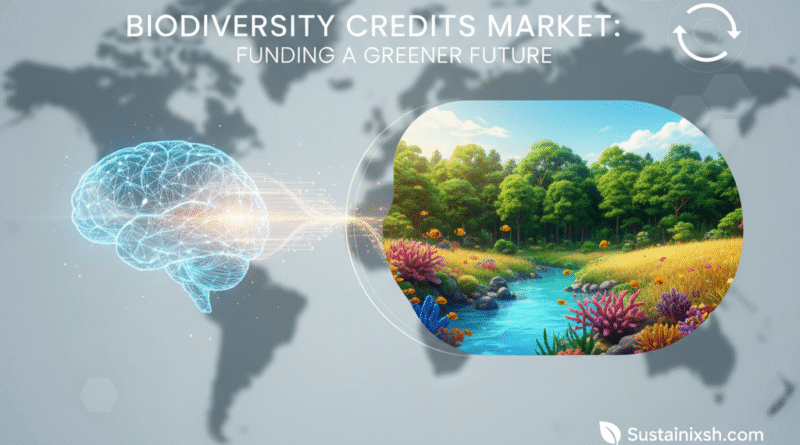Biodiversity Credits Market: Funding a Greener Future
The Buzz About Biodiversity Credits: Funding a Greener Future
Have you ever wondered how we can better protect our planet’s incredible variety of life? We’re talking about everything from the smallest insects to the largest whales, and all the diverse habitats they call home. For ages, conservation efforts have largely relied on public funding and philanthropy. However, as environmental challenges grow, we clearly need more innovative solutions. This is where the exciting new biodiversity credits market steps in, offering a fresh approach to financing vital ecological work.
The growing development of a voluntary market for biodiversity credits aims to channel private finance toward measurable, localized ecosystem restoration and conservation outcomes. This mechanism isn’t just a fancy idea; moreover, it’s a practical way for businesses and individuals to directly invest in projects that genuinely make a difference. As a result, we can unlock significant private capital to support our planet’s natural infrastructure.
What Exactly Are Biodiversity Credits?
Think of biodiversity credits as a tangible unit representing a positive, measurable impact on nature. Just as carbon credits account for reductions in greenhouse gas emissions, biodiversity credits quantify improvements in the health and extent of ecosystems. Therefore, one credit might represent the restoration of a specific area of wetland or the protection of a critical habitat for an endangered species.
In essence, these credits allow projects focused on ecological restoration and conservation to generate revenue. Moreover, this revenue can then be reinvested into further conservation work, creating a sustainable funding cycle. Businesses, on the other hand, can purchase these credits to demonstrate their commitment to environmental stewardship, mitigate their impact, or meet voluntary sustainability goals. Thus, it’s a win-win for both nature and corporate responsibility.
How Do Biodiversity Credits Work?
The process usually begins with a conservation or restoration project. For instance, this could be anything from planting native trees to restoring degraded coastal mangroves.
- Project Development: First, an organization identifies a site for conservation or restoration, developing a detailed plan. This plan includes clear, measurable goals for biodiversity improvement.
- Methodology and Verification: Moreover, these projects must follow robust methodologies to quantify their biodiversity uplift. Independent third-party verifiers then assess these projects to ensure that the stated environmental benefits are real, additional (meaning they wouldn’t have happened otherwise), and lasting. Therefore, this rigorous verification process builds trust in the biodiversity credits market.
- Credit Issuance: Upon successful verification, biodiversity credits are issued. Each credit typically represents a specific unit of biodiversity gain, often measured over time or across a certain area.
- Marketplace and Trading: These credits are then offered on a voluntary market. Buyers, which can include corporations, financial institutions, or even individuals, purchase them to meet their sustainability targets. As a result, the funds flow directly back to the conservation project.
This structured approach ensures transparency and accountability, crucial elements for the success of any environmental market. Furthermore, it encourages high-quality projects with genuine ecological impacts.

Driving Private Finance Towards Conservation
One of the most significant advantages of the biodiversity credits market is its potential to unlock private finance. Historically, conservation has struggled with underfunding. However, businesses increasingly recognize the risks associated with biodiversity loss, from supply chain disruptions to reputational damage. Consequently, they are seeking credible ways to address their environmental footprint.
By purchasing biodiversity credits, companies can:
- Demonstrate Environmental Responsibility: Show stakeholders, customers, and investors their commitment to positive environmental action.
- Address Nature-Related Risks: Proactively mitigate risks associated with their operations’ impact on nature.
- Support ESG Goals: Contribute to their Environmental, Social, and Governance (ESG) objectives, enhancing their overall sustainability profile.
- Invest in Nature-Based Solutions: Directly fund projects that utilize natural processes to address environmental challenges, such as climate regulation and water purification.
Moreover, the transparency and measurability of these credits offer a clear return on investment in terms of environmental impact. Therefore, more and more organizations are exploring this avenue as a strategic component of their sustainability strategies.
The Role of Technology and Standards
The effectiveness and integrity of the biodiversity credits market heavily rely on robust standards and innovative technology. Indeed, sophisticated monitoring tools, including satellite imagery, AI, and on-the-ground sensors, are crucial for accurately measuring biodiversity outcomes. In addition, blockchain technology is being explored to ensure transparency and prevent double-counting of credits.
Furthermore, several international initiatives are working to develop standardized methodologies and frameworks for biodiversity credit projects. As a result, buyers can have confidence that they are investing in high-quality, impactful projects, regardless of where they are located. This harmonization is essential for scaling the market globally and ensuring its long-term credibility.
Localized Impact and Global Reach
A core principle of biodiversity credits is their focus on localized outcomes. Unlike some broader conservation initiatives, these credits often support projects tailored to specific ecosystems and communities. For example, a project might focus on restoring a particular coral reef or protecting a unique forest ecosystem.
- Community Engagement: Many successful projects involve local communities, providing economic opportunities and fostering a sense of ownership over conservation efforts. Therefore, this community-centric approach often leads to more sustainable and impactful results.
- Measurable Results: The emphasis on measurable outcomes means that investors can see the direct impact of their contributions. Moreover, this transparency helps build trust and encourages further investment in the biodiversity credits market.
- Ecosystem Services: Beyond just species protection, these projects often enhance vital ecosystem services, such as clean water provision, pollination, and carbon sequestration. As a result, the benefits extend far beyond the immediate biodiversity gains.
Therefore, while the market operates globally, the positive effects are deeply rooted in specific places, addressing local ecological needs with global financial support.

Challenges and Opportunities Ahead
While the biodiversity credits market holds immense promise, it’s still in its early stages and faces several challenges. Defining and measuring “biodiversity” can be complex, and ensuring the additionality and permanence of impacts requires careful planning and monitoring. Furthermore, preventing greenwashing and maintaining market integrity are paramount.
However, these challenges also present opportunities. The drive to overcome them is fostering innovation in ecological measurement, verification, and market governance. As methodologies mature and global standards emerge, the market is poised for significant growth. Moreover, increasing public awareness of biodiversity loss is creating a greater demand for effective solutions, further fueling interest in this innovative financing mechanism.
Ultimately, the biodiversity credits market offers a compelling pathway to bridge the funding gap for nature conservation. By connecting private capital with tangible, measurable ecological outcomes, it presents a powerful tool for building a greener, more resilient future for all. It truly is an exciting time for environmental finance!




